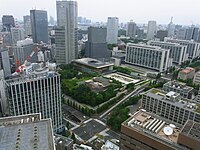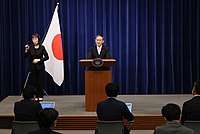Naikaku Sōri Daijin Kantei
 From Wikipedia the free encyclopedia
From Wikipedia the free encyclopedia
You can help expand this article with text translated from the corresponding article in Japanese. (October 2023) Click [show] for important translation instructions.
|
| Naikaku Sōri Daijin Kantei | |
|---|---|
内閣総理大臣官邸 | |
 The east façade of the new Office Building | |
| General information | |
| Address | 2-3-1 Nagatachō Chiyoda-ku 100-8968 |
| Town or city | Tokyo |
| Country | Japan |
| Coordinates | 35°40′23″N 139°44′35″E / 35.673°N 139.743°E |
| Current tenants | Prime Minister of Japan, Cabinet Secretariat |
| Construction started | May 22, 1999 |
| Completed | April 22, 2002 |
| Height | 35 meters |
| Technical details | |
| Floor count | 5 floors above ground, 1 basement |
| Floor area | 25,000 m² |
| Grounds | 46,000 m² |
| Design and construction | |
| Architect(s) | Ministry of Land, Infrastructure, Transport and Tourism, Minister's Secretariat |
| Website | |
| kantei.go.jp | |
The Naikaku Sōri Daijin Kantei (内閣総理大臣官邸) or Prime Minister's Office is the official workplace of the Prime Minister of Japan. It is commonly referred to as Shushō Kantei (首相官邸), or simply Kantei (官邸). Unlike many other famous offices or palaces of heads of states, such as the Kremlin in Russia or the White House in the United States, the Japanese Prime Minister's Office has no nickname. Naikaku Sōri Daijin Kantei literally translates to "Prime Minister's Office" in English.
Located at 2-3-1 Nagata-chō, Chiyoda-ku, Tokyo 100–8968, it is diagonally adjacent to the National Diet Building. The term Kantei is used as a metonym for the office of the Prime Minister of Japan and for the Prime Minister's advisors and administration in general.
In addition to being the principal office of the Prime Minister, the building also serves as the principal office of the Chief Cabinet Secretary and their Deputy, the location of Cabinet meetings, and is also the location of a national crisis management center.[1]
Usage
[edit]The 1st floor contains a press conference room where the Prime Minister and the Chief Cabinet Secretary hold press conferences. On the 4th floor there is a room where the Cabinet holds meetings, summits, etc. The 5th floor has the Prime Minister's Office, their Reception Room, the Chief Cabinet Secretary's office and reception room. [2]
History
[edit]Current Office
[edit]A new five-storied office building was built in 2002, with 2.5 times the floor space.[3] Installed with solar panels and a rainwater storage system, the new building has been designed to minimize environmental impact.[4] The new residence went into service in April 2002[5]
In an April 2015 incident, a Phantom 2 drone carrying traces of radiation was found on the roof of the PM's office.[6]
- The west façade of the Kantei (valley side)
- Kantei viewed from the Kasumigaseki Building in 2010
- Ministerial reception room
- Cabinet room
- Stairs between the 2nd and 3rd floors. Commemorative photo after the cabinet formation
- Hall
- Honor guard in the hall
- Special Reception Room
- Meeting with the Prime Minister in the press conference room. Behind it is the blue curtain used by the Prime Minister
- Green curtain for meeting with the Chief Cabinet Secretary
- The Prime Minister's press conference in the lobby
Previous Office
[edit]The former office building is now known as the Naikaku Sōri Daijin Kōtei (内閣総理大臣公邸), the Prime Minister's personal residential quarters.
With the evolution of a national parliament after the Meiji Restoration and the establishment of the post of "Prime Minister of Japan" in 1885, the need for an official prime ministerial residence was felt. On the encouragement of Prime Minister Tanaka Giichi, the first residence was completed on 18 March 1929. It incorporates architectural styles such as Art Deco and expressionist architecture which became popular from the late Taishō period to the early Shōwa period. It was heavily influenced by the architecture of Frank Lloyd Wright, in particular his design for the second Tokyo Imperial Hotel. It is a two-storied mansion designed by Muraji Shimomoto, of the Ministry of the Treasury (now Ministry of Finance).[7] Prime Minister Tanaka is said to have exclaimed, "This is just like a café, isn't it?",[8] upon seeing the building.
By the 1990s, the old 5,200 square metres (56,000 sq ft) building was deemed cramped and insufficient. It underwent seismic retrofitting and internal renovation.[9]
Notes
[edit]- ^ "Support staff at Kantei". Cabinet Secretariat of Japan. Retrieved 2009-05-29.
- ^ "首相官邸へようこそ". 1996-11-08. Archived from the original on 1996-11-08. Retrieved 2023-12-04.
- ^ "An Overview of the Prime Minister's Official Residence". Cabinet Secretariat of Japan. Retrieved 2009-05-29.
- ^ "Environmental measures and barrier-free environment". Cabinet Secretariat of Japan. Retrieved 2009-05-29.
- ^ "Overview of the Prime Minister's Official Residence". Cabinet Secretariat of Japan. Retrieved 2009-05-29.
- ^ Drone 'containing radiation' lands on roof of Japanese PM's office April 22, 2015 The Guardian Retrieved May 4, 2015
- ^ "An Overview of the Prime Minister's Official Residence". Cabinet Secretariat of Japan. Retrieved 2009-05-29.
- ^ "The Entrance Hall". Cabinet Secretariat of Japan. Retrieved 2009-05-29.
- ^ "外観・正面玄関". Prime Minister's Office of Japan. May 30, 2020. Archived from the original on April 27, 2022.














